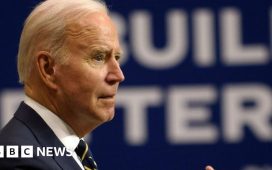The U.S. Navy is fishing fragments of a Chinese spy balloon out of the Atlantic Ocean, and each fresh detail about this episode raises new and troubling questions. A striking example is the news from the Biden Administration that previous Chinese balloon incursions into the U.S. appear to have gone undetected. This suggests there’s a major hole in U.S. defenses that needs closing.
A senior defense official told reporters on Feb. 2 that a balloon incursion “has happened a handful of other times over the past few years, to include before this Administration. It is appearing to hang out for a long period of time this time around, more persistent than in previous instances.”
The Biden Team was leaking over the weekend that balloons had snuck into U.S. airspace during the Trump Administration, and the obvious implication was to absolve President Biden of political blame. More than one media outfit took the bait. But then Trump officials started denying on the record that they’d ever heard of such an event—from former national security adviser
John Bolton
to Defense Secretary
Mark Esper
to Secretary of State
Mike Pompeo.
The Administration’s attempt to muddy responsibility is bad enough, but the revelation that at least three past balloon flights evaded U.S. notice is alarming. “I will tell you that we did not detect those threats,” Air Force Gen.
Glen VanHerck
of U.S. Northern Command told reporters on Monday. In Pentagon argot for the ages, he called it “a domain awareness gap.” The U.S. government ostensibly pieced the puzzle together later with the help of the intelligence community.
This after-the-fact discovery isn’t reassuring, since in a war there would be no chance for do-overs. The balloon was hardly a birthday party fly-away: Up to 200 feet tall, with a payload weighing more than 2,000 pounds, and potentially with explosives to self-detonate if China so chose.
These details are supposed to support the Pentagon’s case for waiting to shoot down the object until it crossed into the Atlantic, but the Biden team is lucky the balloon didn’t come down sooner in a populated part of the country.
Congress now has an opportunity to conduct productive oversight, including assembling a detailed timeline of events that can better explain when this Administration first detected the balloon, how it did so, and why it didn’t shoot it down over Alaska’s wide-open spaces. Would the Administration have even told the public about the balloon if it hadn’t been spotted by civilians looking up at the sky in Billings, Mont.?
The Administration’s talking points also need stress testing. The Pentagon is saying the balloon wasn’t collecting better intelligence than low-earth satellites, but could the Beijing blimp hover longer on areas of interest and collect better pictures? Why would Beijing risk the diplomatic blowback from sending the balloon on the eve of an important diplomatic visit by Secretary of State
Antony Blinken
if there was no surveillance benefit?
These columns are among many voices warning that the American homeland is vulnerable to attack—from balloons to hypersonic weapons to cyber intrusions on the electric grid or water supply. Americans are now tuning in to this fact, and Congress and the Administration can use the moment to better protect 330 million civilians on U.S. soil.
Copyright ©2022 Dow Jones & Company, Inc. All Rights Reserved. 87990cbe856818d5eddac44c7b1cdeb8
Appeared in the February 7, 2023, print edition.








